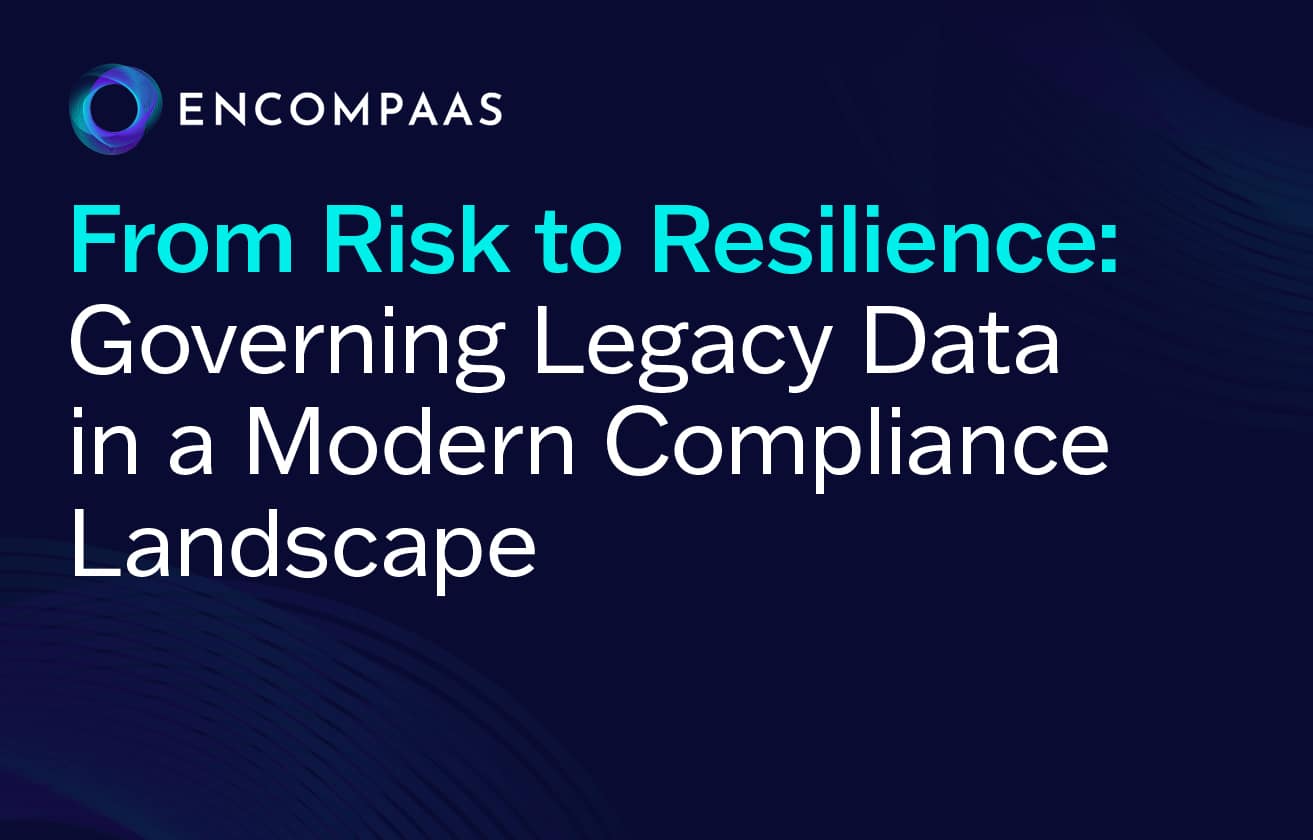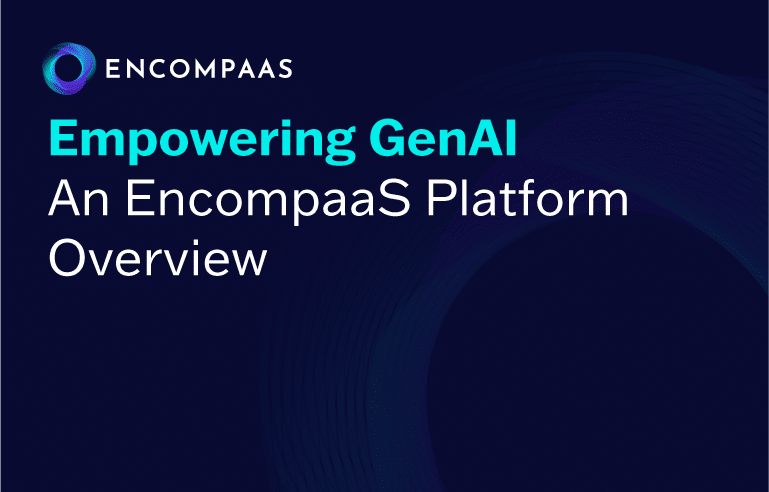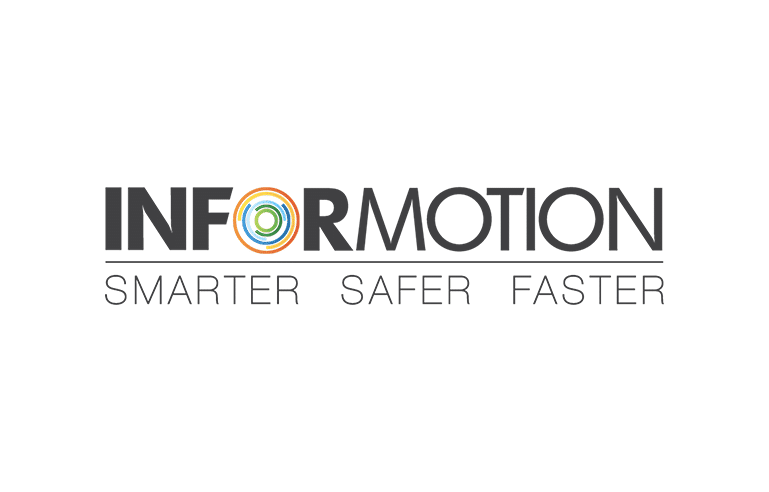Navigating data compliance: Best practices and solutions
Authored by EncompaaS - Mar 22, 2023
Share

In today’s data-driven world, organizations collect, store, and process vast amounts of information. This data often includes private and sensitive personal information, making it crucial for organizations to prioritize data compliance measures.
The commitment to data compliance demonstrates organizations’ dedication to operating with integrity and earning public trust. However, navigating the complex landscape of data compliance can be overwhelming.
This article aims to equip you with knowledge of data protection laws and best practices for fulfilling compliance requirements and protecting sensitive information effectively.
Main takeaways from this article:
- Data compliance involves adhering to legal and regulatory frameworks that govern data protection and privacy. It ensures that data is handled ethically, individual rights are respected, and the risk of data misuse is minimized.
- Compliance is crucial for consumer protection, ensuring data integrity, avoiding legal repercussions, and maintaining trust and reputation. Non-compliance can result in severe penalties, financial losses, and damaged credibility.
- Various regulations like GDPR, CCPA, HIPAA, PCI DSS, and SOX set specific standards for data handling and protection based on geographical and industry-specific needs.
- Best practices for effectively navigating data compliance include understanding regulatory landscapes, implementing robust data classification and protection policies, regularly training employees, continuously monitoring data use, and having clear procedures for data breach response.
- Navigating the evolving regulatory environment and mitigating the risks of non-compliance are major challenges. Solutions involve staying informed through industry updates, conducting regular audits, and using compliance management software like EncompaaS to streamline processes and adapt to changes.
What is data compliance?
Data compliance refers to adhering to applicable laws, regulations, and standards regarding data protection and privacy. It involves managing data in a way that aligns with these legal and regulatory frameworks. This ensures the data is collected, stored, and used ethically and responsibly, respecting the rights of individuals and minimizing the risk of misuse.
Data compliance vs. data security compliance
Data compliance is often compared to but is distinct from data security compliance.
Data security compliance is a crucial subset of data compliance. It focuses on the technical and organizational measures employed to safeguard data (like encryption, access controls, etc.) from unauthorized access, use, disclosure, disruption, modification, or destruction.
On the other hand, data compliance encompasses the broader legal and regulatory aspects of data handling.
Here’s an analogy to understand how both are interconnected: Imagine data as a valuable asset in your company’s vault. Data compliance is like the security measures you implement to safeguard that asset. Just as you wouldn’t leave your vault wide open, you wouldn’t mishandle sensitive data without proper compliance procedures.
Both data compliance and data security compliance are crucial for a robust data governance strategy, working together to ensure data integrity and security.
Why is data compliance important?
Maintaining data compliance is essential for several reasons:
- Consumer protection: Compliance regulations limit how businesses can use customers’ personal information and empower customers by granting them control over their information.
- Data integrity: Data security measures mandated by compliance regulations help protect data accuracy and reliability, which are crucial for informed decision-making across an organization’s levels.
- Legal compliance: Failing to comply with data protection regulations can have serious consequences, such as hefty fines, reputational damage, and even criminal charges in some cases.
- Trust and reputation: Demonstrating a commitment to data compliance helps build a reputation for being responsible and ethical, which earns customers’ and stakeholders’ trust.
Data compliance regulations and requirements
Keeping up with the ever-changing landscape of data compliance regulations can be a complex task. Different regions and industries have varying requirements, making it crucial to understand the specific rules that apply to your organization.
Here’s a look at some of the most prominent regulations:
General Data Protection Regulation (GDPR)
The General Data Protection Regulation (GDPR) is a regulation enforced by the European Union (EU) that outlines strict data protection and privacy requirements for individuals within the EU. It applies to any company that uses the personal information of EU residents, no matter where the company is based.
Here are some key aspects of GDPR:
- Individual rights: GDPR grants EU residents a wide range of rights regarding their personal data, including the right to access, rectify, erase, and restrict the processing of their data.
- Transparency and consent: Organizations must be transparent about how they collect, use, and store personal data and must obtain clear consent from individuals before processing their data.
- Data security: GDPR mandates strong data security measures to protect personal data from unauthorized access, disclosure, alteration, or destruction.
California Consumer Privacy Act (CCPA)
The California Consumer Privacy Act (CCPA) is a law enacted by the state of California that empowers residents with control over their personal information collected by businesses. It applies to businesses that meet certain thresholds concerning data collection and annual revenue.
Here are some key aspects of CCPA:
- Right to know: California residents have the right to know what personal data businesses collect about them, from where the information is collected, and for what purposes it is used and sold.
- Right to access: Residents can also request access to the specific pieces of personal information that a business has collected about them.
- Right to deletion: CCPA grants customers the right to request that businesses delete their personal information, subject to certain exceptions.
- Right to opt-out of sale: Residents have the right to opt-out of selling their personal information to third parties.
Health Insurance Portability and Accountability Act (HIPAA)
The Health Insurance Portability and Accountability Act (HIPAA) is a US law that sets national standards for protecting sensitive patient health information. It applies to healthcare providers, health plans, and healthcare clearinghouses that transmit patient medical information electronically.
Here are some key aspects of HIPAA:
- Protected health information (PHI): HIPAA defines specific categories of patient data as Protected Health Information (PHI). This includes information like medical history, diagnoses, treatment plans, and billing details.
- Security and privacy standards: HIPAA mandates implementing security and privacy measures to safeguard PHI.
- Patient rights: HIPAA grants patients certain rights regarding their health information, including the right to access, amend, and request an accounting of disclosures of their PHI.
Payment Card Industry Data Security Standard (PCI DSS)
The Payment Card Industry Data Security Standard (PCI DSS) is a universal standard created to secure credit and debit card transactions and protect cardholder data from unauthorized access and misuse. Developed by the PCI Security Standards Council, it applies to any organization that accepts, transmits, or stores credit card information.
Here are some key requirements of PCI DSS:
- Build and maintain a secure network: This includes maintaining firewalls, using strong password management practices, and protecting systems from malware and vulnerabilities.
- Protect cardholder data: Cardholder data, such as credit card numbers and expiration dates, must be encrypted when at rest and in transit.
- Maintain a vulnerability management program: Regularly scan systems for vulnerabilities and implement a patching process to address them promptly.
- Implement strong access control measures: Restrict access to cardholder data based on the principle of least privilege. Multi-factor authentication should be used for privileged access.
- Regularly monitor and test networks: Always monitor network traffic to look for any unusual activity and perform tests to find and fix any possible security problems.
- Maintain a security policy: Develop and document a comprehensive information security policy that outlines the organization’s approach to data security and PCI DSS compliance.
Sarbanes-Oxley Act (SOX)
The Sarbanes-Oxley Act (SOX) is a US federal law enacted in 2002 in response to a series of high-profile accounting scandals. The aim of SOX is to protect investors and the public from corporate fraud by mandating more stringent financial reporting and record-keeping practices for publicly traded companies. Here are some key aspects of SOX:
- Internal controls: SOX mandates that companies create and uphold internal controls for financial reporting. These controls guarantee that financial statements are accurate and complete.
- Public Company Accounting Oversight Board (PCAOB): SOX established the PCAOB, an independent board responsible for overseeing the audits of public companies.
- Financial reporting: SOX mandates that CEOs and CFOs personally certify the accuracy of their company’s financial statements.
Best practices for data compliance
Data compliance is an ongoing commitment to protecting information. Here are seven best practices to empower your organization:
1. Understand and map your regulatory environment
The first step to successful compliance is understanding your data environment. Continuously assess and stay informed about the data regulations that apply to your industry and geographical location. Regulatory mapping tools are invaluable assets in this process, helping you create a comprehensive understanding of all compliance aspects of the data you handle.
2. Implement robust data classification systems
Not all data is created equal. Establish clear categories for your data based on its sensitivity. This allows you to apply specific security and compliance measures effectively and helps you prioritize resources and controls. Sensitive data, like financial records or customer information, naturally demands a higher level of protection compared to less sensitive data.
3. Develop comprehensive data protection policies
Clear and concise policies are the cornerstones of data security. Develop comprehensive policies defining how your organization handles, processes, and stores data. These policies should be readily available to all employees and regularly updated to reflect the latest legal standards. With these clear guidelines, you empower your workforce to be responsible stewards of the data entrusted to them.
4. Regularly train employees on compliance requirements
Data compliance isn’t a one-time event; it’s an ongoing journey. Conduct regular training sessions to inform your staff about the latest compliance policies and best practices. These sessions should be engaging and informative, ensuring employees understand their role in data security. Emphasize the importance of compliance in daily operations and how it promotes trust with customers.
5. Monitor and audit data usage continuously
Continuous data usage monitoring is essential for robust data security. Implement monitoring systems to track data access and usage patterns. These systems provide a real-time activity view, allowing you to identify any unusual or suspicious behavior. Regularly audit these logs to detect and rectify any non-compliant activities before they escalate into major issues.
6. Establish clear procedures for responding to data breaches
Even the most secure systems can be vulnerable. Prepare and maintain a well-defined data breach response plan that outlines clear communication strategies and notification procedures. This plan should be readily available to all relevant personnel and include details on who to notify, what information needs to be communicated, and the steps to take to mitigate the breach.
7. Document all compliance processes for accountability
Maintaining detailed records of your compliance activities is crucial for demonstrating accountability. Keep detailed records of all compliance activities, including training materials, audit reports, and policy revisions, to provide evidence of your compliance efforts during audits and help you identify areas for improvement in your processes and training methods.
Challenges in data compliance and how to overcome them
While the best practices outlined above lay a solid foundation for data compliance, there can be hurdles, too. Here’s a look at some common challenges and how to overcome them:
Non-compliance violation and consequences
Data breaches and non-compliance incidents can have severe consequences. Here are a couple of examples to illustrate their impact:
- Example 1: A major retailer experiences a data breach exposing millions of customer credit card details. The company faces hefty fines from regulatory bodies, reputational damage, and lawsuits from affected customers.
- Example 2: A healthcare provider fails to adequately secure patient medical records, violating HIPAA regulations. The organization faces significant financial penalties and a potential loss of patient trust.
These examples highlight the importance of robust data security measures. Preventative measures such as data encryption, access controls, and employee training can significantly reduce the risk of breaches and non-compliance incidents.
Adapting to changing regulations
The regulatory compliance surrounding data privacy is constantly evolving. Here’s how you can stay ahead of the curve:
- Subscribe to industry publications and regulatory authority updates to stay informed about changes in national and international data protection regulations.
- Conduct regular compliance audits to identify any gaps and ensure you’re adapting to evolving regulations.
- Utilize compliance management software with built-in regulatory change trackers. EncompaaS, for example, can be a valuable tool in this regard with its features like automated data discovery and classification, helping you identify and adapt your compliance measures as regulations evolve.
Enhance your compliance strategy with EncompaaS
The amount of data organizations collect grows exponentially and maintaining a compliant data environment can be a complex and resource-intensive task. This is where EncompaaS steps in as your trusted partner.
With a suite of features designed to streamline your data compliance efforts, EncompaaS offers:
- Automated data discovery and classification: EncompaaS can automatically identify and classify your data based on sensitivity, saving you valuable time and resources.
- Data quality management: Ensure the accuracy and completeness of your data to minimize the risk of errors that could lead to compliance violations.
By leveraging EncompaaS’ comprehensive data management tools, you can gain the flexibility and adaptability needed to navigate the ever-changing world of data compliance with confidence.
Book a demo now and see for yourself how our data privacy and compliance solutions can help you remain a leader in data security and build trust with your customers and stakeholders.
Book a demo
Let's get started
Experience the Power of EncompaaS!
Submit this form to see EncompaaS in action with a demo from our information management experts.
Related Resources

- Blog

- Blog



